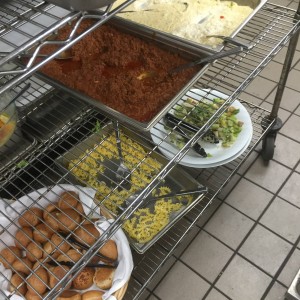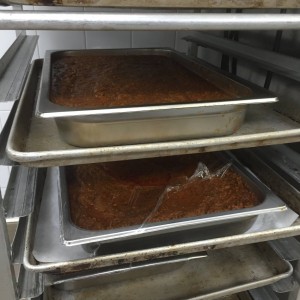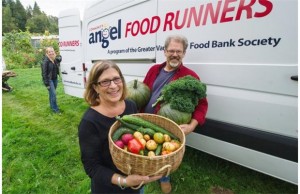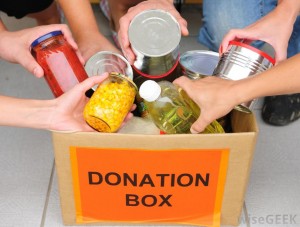Introduction
Aim: The aim of Food Wise is to create a connection between food banks and the foodservice industry to reduce food waste and increase donations to food banks.
Significance:

Whether eating out at a restaurant or preparing food at home, Vancouverites waste over “100,000 tonnes of edible food, beverage and dairy products” each year (Chan, 2015).. The birth of Food Wise began at Marriott Hotel in Richmond, B.C. where Santiago decided to focus on a method which could improve the management of perishable foods kept in warmers, away from the public during the event, known as “backup”. The backup chafing dishes do not make it out onto the service table due to a low turnout rate or quantity consumed by guest was below the expected. The pictures below depict four “backup” chafing dishes which correspond to approximately 120 portions, according to Michael Gonzales, a chef at Marriott Hotel. Gonzales remarks this amount of leftover food is normal for large events they cater every weekend.
Limitations: Quantifying the average food waste from hotels, becomes an inaccurate task because it varies in each event, as turnout rate and quantity consumed often vary.

Objective: Food Wise’s objective to improve food security in Metro Vancouver by increasing the amount of donations from restaurants, hotels, and catering companies to food banks, and in turn decrease the amount of food waste generated by these food retailers.
Inquiry Question: How viable is the expansion of Food Wise? Will an expansion be able to include every hotel willing to participate, and would the surplus generated aid towards reducing food insecurity in Metro Vancouver?
Background and significance

Food waste is major issue in Canada. Abdulla et al. (2013) purport that “the largest contributor to food waste is the consumer,” as “more than 50 percent of the estimated CAD27 billion worth of waste that ends up at landfills…” (p.138). In addition, food insecurity is prevalent in Vancouver, as Dietitians of Canada (2011) reports “7.7% of British Columbians are considered food insecure” (p.3). They report that food insecure households face restraints from low income, lack of knowledge for food preparation, mobility, and purchasing power (p.3). Food Wise hopes to address food waste and insecurity by rescuing leftover food and donating it to nonprofits which can redistribute it to those in need. According to the Greater Vancouver Food Bank (2012), their food rescue program, the Angel Food Runners, saves about 400 tonnes of food each year. This amount only accounts to 4% of food that is thrown out each year in Vancouver. Taking a look at other similar and successful food rescue programs, we hope to communicate with them to gain knowledge on how they operate and if they could manage to take in more donations. Directions, a drop-in centre for homeless and at-risk youth in Vancouver, works with Angel Food Runners to collect food waste, while creating meals everyday out of the food they are given. With a budget of under $300 per week for the meals, they have to use what they can get and be creative (Culbert, 2015). We believe that by expanding the food runners program and involving more restaurants and banquet services to donate food, we can allow more community centres to make meals for the homeless, as well as save more food from becoming waste.
The gap we have identified from our research is that there is no information on larger food rescue program networks, they are all run independently and at a small scale. Our project aims to fill this gap through expanding the existing food rescue programs by forming a link between more restaurants and food banks/community organizations. In one piece of literature on the sustainability of retail food recovery, Phillips et al.’s research shows that creating strong links between donors and food banks will allow them to effectively communicate and work together in making sure food is picked up consistently and on time. Building a schedule and creating a strong bond between these two stakeholders is what will allow food rescue to expand.
In summary, the most common themes we came across in the articles we read were the high numbers of food waste in Vancouver and Canada, as well as the large amount of food insecure households. We found programs addressing this issue through food rescue, but they are small and need more connections with restaurants in order to expand and provide more food to people in need. Finally, we found that that research on the sustainability of these food rescue programs is based around forming a strong bond between the donors and food bank.
Research Methods

Conducting Research: We began our project by researching food safety regulations and standards in Canada. Knowing which leftover foods are eligible to be donated to community charities is essential for starting our project, as this information helps identify the hotels and catering companies we should target according to the food safety standards and the equipment they own. We found an organization called Angel Food Runners which provides the transport service for hot meals while strictly abiding by the food safety regulations. Additionally, we conducted online research on nonprofit organizations in Vancouver which have a similar goal as our project in providing food, that would otherwise go to waste, for those in need, in hopes of learning from them.
Collecting Data: Aside from online research, our main means of collecting data is through qualitative interviews. We will firstly attempt to contact the person in charge from Quest and Directions to set up an interview and ask about how their programs began, and their successes and difficulties encountered while running their programs. We will also collect data on the quantity of donated food Quest and
Directions receive each week, the percentage of it that is actually fed back to those in need, as well as the number of people they serve each day. The quantitative data will suggest the approximate amount of food donations needed for our community. We will also attempt to set up an interview with Angel Food Runners to obtain information about their amount of available resources, including trucks and volunteers, to transport and distribute donated food. This information indicates the amount of donated surpluses that is practical for delivery by Angel Food Runners. During the interview with the personnels from the hotels and catering companies, we will ask about their food waste management and then explain the idea of donating edible leftovers to charities, and see if they would be interested in participating in our program. Although we are conducting qualitative interviews, most of the answers that we receive could be quantified, such as the quantity of food donated to Quest and Directions, and the amount of food picked up by Angel Food Runners. These numbers could be easily analyzed and interpreted, however the responses that aren’t quantified such as whether or not stakeholders and consumers are interested in our project need more analysis. We will analyse these responses by making a scale consisting of “not interested”, “neither interested nor not interested”, and “very interested” and place the interviewees in between the scale.
Conducting Survey: We will conduct a survey asking potential consumers and catering establishments if they believe it is a good idea to reduce edible food waste in the foodservice industry by donating to nonprofits. If their opinion on our project is very positive, it could become an incentive for other restaurants, caterers, and hotels to participate in our program. By analyzing the responses, we hope to get a clear understanding on their stance on Food Wise and whether this project has a potential chance for success.
Ethical considerations: We will respect and protect the privacy of all the stakeholders and potential consumers participating in our project. The consent form from the LFS website will be provided for the stakeholders to sign before starting the interview. We will not take any pictures and record any interviews without permission. Also, we will keep the name of the potential consumers confidential. The data and pictures will only be used for our project and will not be disclosed without the permission from our stakeholders.

Success factors
Meaning of Success: The success of Food Wise will come from our follow-up with the Food Bank and Angel Food Runners to see whether weekly donations have increased by 10%. We chose 10% because we think it is a feasible amount to achieve in the short time we have for this project. We will determine this by using our data collected from the interview on the amount of food they currently receive and compare it to the amount they receive after Food Wise is implemented. Our success will also come from knowing whether we have created an impact on food insecurity by seeing a 10% increase in the
number of visitors served at the food bank and other non-profits like Directions. This would mean the food bank is receiving more food from donors to support families that would often get rejected due to the lack of donations. Finally, we would also like to see a 10% decrease in food waste from the hotels/restaurants. We can measure this by measuring food waste before and after implementation for one hotel that we work closely with, such as the Marriott. The success of our Food Wise project may even encourage us to continue expanding our idea, outside the LFS 350 scope, into an organization that will strive to reduce food waste and improve food security by connecting the food industry with food banks. Our success will help our community partners receive greater attention from the public and foodservice industry. Food bank programs and the Angel Food Runners will acquire more donations from foodservice organizations, while restaurants will see a success through the reduction of food waste in their kitchen and being able to showcase their community service through donations.
Steps to success: Finding suitable community partners will help Food Wise succeed. We chose to contact Directions and Quest because their programs combat food reduction in unique ways where, Directions cooks hot meals for low-income households, while Quest sells surplus produce at a price significantly lower than the market price. Interviewing them will help us understand how we can create a program that will also be unique in reducing food waste, as well as helping food insecure households. We will also interview roughly 5 companies in the foodservice industry to see if they experience food waste from surplus foods and if they would be interested in donating their prepared meals to food banks. By suggesting to donate their surplus food, we hope that some of the companies will consider our idea as a feasible way to help both problems of food waste and low-income households. Next, we will interview around 12 consumers to ask whether they believe food waste is an issue in Vancouver and whether they would support companies donating their food to food banks. We hope that through this interview, consumers will be aware about waste and, perhaps, donate more food to food banks. Finally, a major step to success is setting up an interview with Angel Food Runners to understand their process of food pickups and deliveries to food banks. Once we discover how their program operates, we can help them expand and improve their service by publicizing their concerns to the City of Vancouver.
Implications: Food Wise hopes the public will become more aware of food waste in Vancouver and in private venues. Perhaps, the public will choose food bank programs as a way to donate untouched, nonperishable foods from their homes rather than discarding them. We hope our project will also impact food service companies to participate in food bank programs that will accept and repurpose their surplus meals. Finally, Food Wise would like the City of Vancouver to consider our food reduction strategy as a feasible path to combatting food insecurity and food waste.
Works Cited
Abdulla, M., Martin, R. C., Gooch, M., & Jovel, E. (2013). The importance of quantifying food waste in Canada. Journal of Agriculture, Food Systems, and Community Development, 3(2), 137-151. http://dx.doi.org/10.5304/jafscd.2013.032.018
Chan, K. (2015, May 15). 100,000 tonnes of edible food annually wasted in Metro Vancouver. Vancity Buzz. Retrieved from http://www.vancitybuzz.com/2015/05/food-waste-in-metro-vancouver/
City of Vancouver. (2013). What feeds us: Vancouver food strategy. Retrieved from http://vancouver.ca/files/cov/vancouver-food-strategy-final.PDF
Culbert, L. (2015, April 22). Chef uses rescued food to dish up meals for Vancouver youth (with video). Retrieved from http://www.vancouversun.com/Chef+uses+rescued+food+dish+meals+Vancouver+youth+with+video/10992185/story.html?__lsa=7d9a-4a3a
Dieticians of Canada (2011). The cost of eating in British Columbia. Retrieved from http://www.dietitians.ca/Downloads/Public/CostofEatingBC2011_FINAL.aspx
Greater Vancouver Food Bank. (2012). Community angel food runners program. Retrieved from https://www.foodbank.bc.ca/programs/community-angel-food-runners-program
Quest Food Exchange. (2013). About Quest Food Exchange. Retrieved from http://www.questoutreach.org/about/
Phillips, C., Hoenigman, R., Higbee, B., & Reed, T. (2013). Understanding the sustainability of retail food recovery. PLOS, 8, doi: 10.1371/journal.pone.0075530
Robinson, M. (2014, Oct 2). For Vancouver restaurants, it’s not easy being green. Retrieved from http://www.vancouversun.com/business/Vancouver+restaurants+easy+being+green/10257218/story.html?__lsa=7d9a-4a3a